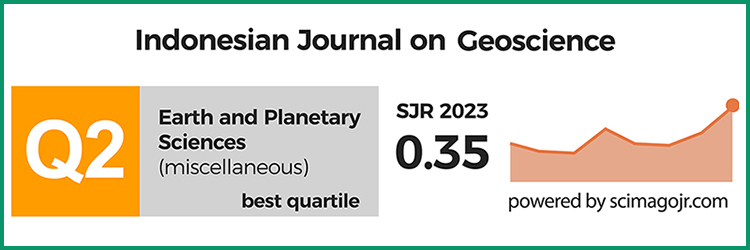Kemungkinan sebaran zirkon pada endapan placer di Pulau Kalimantan
DOI:
https://doi.org/10.17014/ijog.2.2.89-97Keywords:
zircon, placer, continental, transition and marine environmentAbstract
https://dx.doi.org/10.17014/ijog.vol2no2.20073
Most alluvium with valued heavy minerals originated from regions of continental shelf, from which recycle process for stable minerals play an important role in transportation and final concentration formation of the minerals. Kalimantan Island as part of continental shelf has a great opportunity to provide condition or environment for placer deposition with zircon content due to: comprising particularly basement rock of calc-alkali to alkali series (granite, granodiorite, tonalite and monzonite) which were suggested as the main supplier sources of zircon; having a long period of regional stability as main contribution in continuation processes of weathering, transportation and forming deposition environment of alluvium and located within a tropical climate with high humidity from which mechanical and chemical weathering processes play an important role in releasing zircon from its source rocks.
Continental placer deposit of fluvial sub-environment category is suggested to have possibility to form deposition zone lying between the mountains and the seas, reaching over wide areas and forming huge volume reservoirs with content of zircon. Based on zircon identification (associated with gold or diamond) of placer pan concentrates at some areas of West Kalimantan and Central Kalimantan, these have proved how widespread of zircon deposition within fluvial sub-environments in both regions. This important information inspires an opportunity to do exploration of placer zircon deposits within fluvial sub-environments in entirely Kalimantan Island, without neglecting to the transition placer of strandline sub-environment category and marine environment which enable to have an economic deposit of zircon.
References
Friedman, G.M. and Sanders, J.E., 1978. Principles of Sedimentology, John Wiley & Sons, New York.
Haile, N.S., 1968. Geosynclinal Theory and Organizational Pattern of The Northwest Borneo Geosyncline. Quarterly Journal of Geological Society, London 124, h.171-195.
Haile, N.S., McElhinny, M.W., and McDougal, I., 1977. Paleomagnetic Data and Radiometric Ages from The Cretaceous of West Kalimantan (Borneo) and Their Significance in Interpreting Regional Structure. Geological Society of London Quaternary Journal, 133, h.133-144.
Hamilton, W., 1978. Tectonics of The Indonesian Region, USGS Prof. Paper 1078.
Hutchison, C.S., 1973. Tectonic Evolution of Sundaland: A Phenerozoic Synthesis, Geol. Soc. Malaysia, Bulletin 6, July, h.61-68.
_________, 1975. Ophiolite in South Asia. Bulletin of Geological Society of America, 86, h.797-806.
Katili, J.A., 1973. Geochronology of West Indonesia and Its Implication on Late Tectonics. Tectonophysics 19, h.195-212.
________, 1981. Geology of South Asia with Particular Reference to The South China Sea. Bulletin of the Geological Research and Development Center of Indonesia No. 4, March 1981, h.1-12
Macdonald, E.H., 1983. Alluvial Mining – The geology, technology and economics of placers, London-New York, Chapman and Hall.
Pupilli, M., 1973. Geological Evolution of South China Sea Area Tentative Reconstruction from Borderland Geology and Well Data Proceeding. Indonesian Petroleum Association, Second Annual Convention, Proceedings.
Rodiana Eddy, H., 2007. Potensi Pasir Zirkon di Provinsi Kalimantan Barat dan Kalimantan Tengah, Buletin Sumber Daya Geologi, Vol. 2 No. 1, April 2007.
Tim Konservasi Kapuas Hulu, 2006. Laporan Evaluasi Sumber Daya Cadangan Bahan Galian Untuk Pertambangan Skala Kecil di Kapuas Hulu, Kalimantan Barat. Departemen Energi dan Sumber Daya Mineral, Badan Geologi, Pusat Sumber Daya Geology.
Van Bemmelen, R.W., 1949. The Geology of indonesia. The Hague Netherland Gov. Printing Office



















